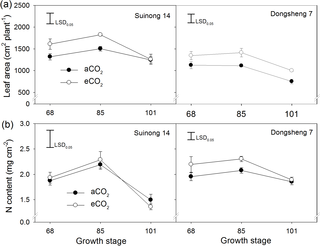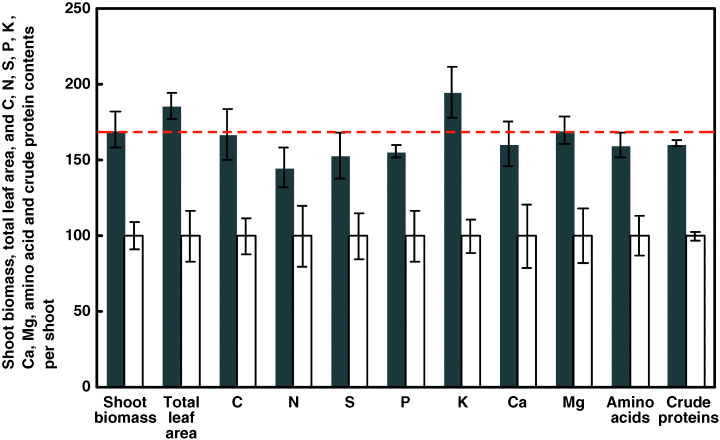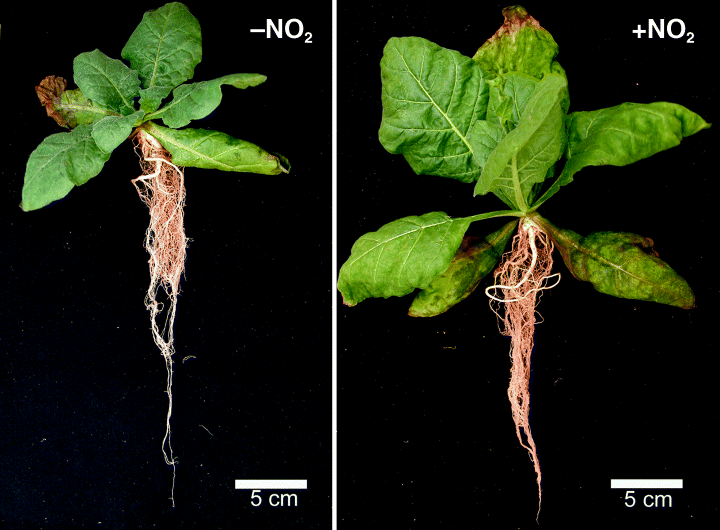October 21, 2020 at 9:41 pm | Updated March 16, 2022 at 11:33 am | 6 min read
The rising air pollution worldwide has spurred research into possible beneficial or adverse effects on plants and crops. These surprising findings provide an insight into the internal processes of plants that were otherwise unknown. New technological developments are being used in this field of science that give precise measurement and analyses of many plant features to scientists, on the move and in real-time.
Air Pollution
Air pollution has increased dramatically in recent decades. The main increases have been in gases such as carbon dioxide (CO2) and nitrogen dioxide (NO2), among others. While these pollutants are harmful to the environment, people, and wildlife, their interactions with plants are less straightforward.
CO2 is an essential raw material without which plants cannot produce their food, and NO2 can act as a nutrient for the plants.
Subscribe to the CID Bio-Science Weekly article series.
By submitting this form, you are consenting to receive marketing emails from: . You can revoke your consent to receive emails at any time by using the SafeUnsubscribe® link, found at the bottom of every email. Emails are serviced by Constant Contact
So, is an increase in these gases beneficial for the plants? Are there any adverse effects?
The impact of air pollutants on plants can be gauged by studying internal physiological processes or their phenotypic expression on growth and yield parameters. Growth parameter readings should ideally be non-destructive if they are to be repeated often.
Measuring internal processes can be more challenging in the field. However, understanding the role of gases in plant physiology can help. For example, the rate of photosynthesis is estimated by measuring the amount of CO2 used by plants and the O2 produced. In cases where monitoring effects of gases are necessary, as in the air pollutants, this offers added insights and the possibility to quantify the impact of an increase in gases in the atmosphere.
A new breed of instruments takes all these factors into consideration while also being accurate and fast. We will discuss how these tools have advanced crop research, studying the effect of gaseous pollutants.
Leaf Area Increase in Soybean due to a Spike in CO2
The level of CO2 was 407.4 parts per million (ppm) in 2018, a substantial hike from 330 ppm in the 1970s. CO2 levels are expected to rise further and reach 580 ppm by the end of this century.
The increase in CO2 has been widely expected to increase crop growth and yield. However, the response, even within a single crop, can vary depending on the cultivar. For example, increase in yield in soybeans can vary from twenty to ninety percent.

Figure 1: “The effect of elevated CO2 on leaf area (a) and N content per unit leaf area (b) during the period from the R4 (68 d), R5 (85 d) to R6 (101 d) stages. (Image credits: https://doi.org/10.1371/journal.pone.0176688.g003)
A Chinese study aimed to discover how elevated CO2 conditions influence leaf canopy distribution, the use of nitrogen in plants, and its impact on crop yield in soybeans (Glycine max L. Merr.). The experiment also included soil type and cultivars as other factors.
Two cultivars of soybean – Suinong 14 and Dongsheng 7 – were grown in two Mollisols at two levels of CO2 – 380 ppm and 580 ppm.
Leaf area measurements were made after sixty-eight days (full pod setting), eighty-five days (initial pod filling), and one hundred and one days (full seed).
The CI-203 Handheld Laser Leaf Area Meter, produced by CID-Bio Inc., was used. The leaf meter has a laser scan that moves over a flattened leaf blade to record its length, width, perimeter, area, shape factor, aspect ratio, and void count. The instrument can do non-destructive readings, and the data can be stored and transferred by a removable Wi-Fi card to the computer.
Two leaflets picked at the different stages were analyzed for dry weight and nitrogen content. At full crop maturity, the shoots were cut and harvest parameters were recorded. Nitrogen content was estimated in various plant tissues.
There was a 2.4 fold increase in leaf area at the lower nodes of the plant due to a rise in CO2, and there was a 4.3 fold increase at upper nodes of the plant and at later stages of plant growth. There was a difference between the two varieties in the extent of leaf area increase and accumulation of leaf nitrogen; see Figure 1. The soil type had no effect on the plants’ performance.
There was a subsequent fourteen to thirty-five percent rise in the yield of the two varieties, mainly due to more production of pods and seeds.
An increase in leaf area due to a rise in CO2 is one of the agronomic features that influences crop yield. A gain in leaf area expands crop canopy, so plants take in more nutrients, like nitrogen, and conduct more photosynthesis, resulting in a boost in biomass production.

Figure 2: Shoot biomass, total leaf area, mineral contents, total free amino acids, and crude proteins in Nicotiana plumbaginifolia plants grown for 10 wk in air containing (+NO2, shaded columns) or not containing (–NO2, open columns). (Image credits: https://nph.onlinelibrary.wiley.com/doi/full/10.1111/j.1469-8137.2005.01493.x)
Leaf Area Increase Reflect Signal Function of Nitrogen Dioxide
Nitrogen dioxide (NO2) levels are rising in the atmosphere as it is produced from burning fossil fuels.
Most studies on the effect of ambient NO2 on plants focus on the nutritional role of the gas or the role of plants to absorb this pollutant. Endogenous NO2 produced by plants is a trigger for many physiological processes in plants. This Japanese study wanted to see if exogenous or atmospheric NO2 could have a similar effect on plants.
Tobacco plants (Nicotiana plumbaginifolia) were germinated from seeds. Two-week-old seedlings were transplanted into pots. After another week, they were separated into two batches. The control plants were kept in the greenhouse with < 5 ppb NO2. Another batch was held in a fumigation chamber with 150 ± 50 ppb NO2. Other environmental and nutrient conditions were the same.
After ten weeks, forty leaves of each batch were measured using the CI-203 Handheld Laser Leaf Area Meter, along with the conveyor attachment, CI-203CA, for rapid measurements. In this experiment, only a one-time analysis was needed; therefore, leaves were picked and laid on the conveyor to speed up measurement of leaf length, width, perimeter, and area.
Besides the leaf measurements, the mineral content of leaves was analyzed with an EA-MS analyzer and spectroscopy for total nitrogen (N), carbon(C), potassium (K), Phosphorus (P), calcium (Ca), and magnesium (Mg). Total free amino acids and crude protein content were analyzed by the Kjeldahl method.
The scientists found that elevated NO2 levels in the air began to increase the size of leaves after six weeks and stabilized by the tenth week. Ultimately, there was a 1.8 times increase in leaf area due to higher NO2 levels, as shown in Figure 1. Moreover, there was also a 1.5-1.9 times increase in shoot biomass, elements, and metabolites in the tobacco plants that got higher levels of NO2.
The scientists concluded that the levels of the pollutant NO2 in the air can nearly double plant size and its cell contents by influencing many internal processes. Earlier studies have shown that NO2 is taken up by the plants, of which only three percent is used as a nutrient. About one-third of the gas is used to form an unsolvable nitrogen (UN) compound. This UN compound acts as a signal that regulates multiple plant processes, including plant growth and photomorphogenesis.

Figure 3: Nicotiana plumbaginifolia plants grown for 10 wk under natural light and irrigation in air containing (right, +NO2) or not containing (left, –NO2) 150 ± 50 ppb 15NO2. (Image credits: https://nph.onlinelibrary.wiley.com/doi/full/10.1111/j.1469-8137.2005.01493.x)
The Versatility of Leaf Meters
Leaf area measurements are not easy. There are a range of shapes and lengths to deal with, not to mention the differences in leaf margin that are very minute. The leaf meter can make precise measurements, regardless of all these challenges. Moreover, differences in leaf thickness do not affect accuracy. By providing a means to take non-destructive readings, the instrument offers possibilities not available to earlier generations of scientists. Since leaves are integral to the growth, health, and yield of plants, this instrument is likely to find a place in many experiments.
—
—
Vijayalaxmi Kinhal
Science Writer, CID Bio-Science
Ph.D. Ecology and Environmental Science, B.Sc Agriculture
Feature image courtesy of United Soybean Board
Sources
Climate Change: Atmospheric Carbon Dioxide: NOAA Climate.gov. (2020, February 20). Retrieved from https://www.climate.gov/news-features/understanding-climate/climate-change-atmospheric-carbon-dioxide
Jin, J., Li, Y., Liu, X., Wang, G., Tang, C., Yu, Z., … Herbert, S. J. (2017). Elevated CO2 alters distribution of nodal leaf area and enhances nitrogen uptake contributing to yield increase of soybean cultivars grown in Mollisols. Plos One, 12(5). doi: 10.1371/journal.pone.0176688
Kleiber, T., Borowiak, K., Schroeter-Zakrzewska, A., Budka, A., & Osiecki, S. (2017). Effect of ozone treatment and light colour on photosynthesis and yield of lettuce. Scientia Horticulturae, 217, 130–136. doi: 10.1016/j.scienta.2017.01.035
Takahashi, M., Nakagawa, M., Sakamoto, A., Ohsumi, C., Matsubara, T., & Morikawa, H. (2005). Atmospheric nitrogen dioxide gas is a plant vitalization signal to increase plant size and the contents of cell constituents. New Phytologist, 168(1), 149–154. doi: 10.1111/j.1469-8137.2005.01493.x
Related Products
Most Popular Articles
- Transpiration in Plants: Its Importance and Applications
- Leaf Area – How & Why Measuring Leaf Area…
- How to Analyze Photosynthesis in Plants: Methods and Tools
- The Forest Canopy: Structure, Roles & Measurement
- Plant Respiration: Its Importance and Applications
- Forest & Plant Canopy Analysis – Tools…
- Stomatal Conductance: Functions, Measurement, and…
- Root Respiration: Importance and Applications
- The Importance of Leaf Area Index (LAI) in…
- Irrigating with Saline or Seawater






